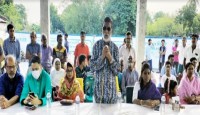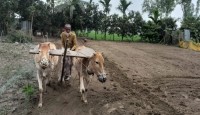Dr. Pamelia Riviere
Rape culture and the systemic abuse of women have emerged as critical issues in Bangladesh since the country's independence in 1971. The alarming prevalence of sexual violence, including rape and gang rape, has drawn significant attention. While the pressures of work have limited my ability to fully explore recent accounts of these crimes, my concern for the safety and treatment of women remains deeply rooted. I am committed to raising awareness and seeking solutions to this pressing problem. Rape Culture Statistics: Globally, incidents of sexual violence against women are shockingly frequent.
According to the World Population Review (2020) on "Rape Statistics," an estimated 35% of women worldwide have faced sexual harassment at some point in their lives. In Bangladesh, the reported incidence of rape is alarming, with approximately 11,682 cases per 100,000 people, resulting in a rape rate of 9.82. This issue transcends borders, as no country, whether developed or developing, is exempt from the prevalence of rape. In India, the situation is equally concerning. In 2022, more than 31,000 rapes were reported, equating to one incident every 16 minutes in 2019. Contributing factors to this high incidence include declining societal morals, as well as challenges related to illiteracy, unemployment, and poverty.
In Canada, the statistics reveal a significant gender disparity in sexual assault victims. Women face a victimization rate of 50 per 1,000, which is five times higher than the rate for men, reported at 9 per 1,000 (Statistics Canada, 2021). These statistics underscore the urgent need for collective action to combat rape culture and protect the rights and dignity of women globally. Rape Culture in Bangladesh Context Bangladesh's population is five times higher than Canada's, but the country's landscape is about 67 times more miniature. I should mention that Bangladesh is only 1.2 times bigger than New York City. In this small land, 171.5 million people live shoulder to shoulder. Moreover, the youth population covers 15 percent of the populace.
After I read a feature on the brutal gang rape of an 8 years old child, Asia, by her sister’s husband, brother, and father-in-law, I felt pain in my heart watching the photos uploaded and shared on social media. Another child 5, years old toddler, Pooja, was brutally raped by a local man. Unfortunately, the predator Saiful was released recently. Looking at the heinous crimes against young girls, it was hard for me to resist not writing a few words on rape culture in Bangladesh and Bangladesh's socio-religio-political stance. These days, every day, rape issues are getting published in the media. The Daily Star reported that last 5 years, 6 thousand girls were raped, and 12 thousand were molested and assaulted in Bangladesh.
We all know Tanu was raped and murdered inside the cantonment, but she did not get justice. Tanu was covered thoroughly, and she wore a hijab, too. So what was the motive for her rape and killing, according to the Bangladeshi preachers. Bangladeshi preachers blame that if girls are not covered, they will be raped because men cannot resist themselves. Is this the teaching of Islam? Did not Islam command that lowering their gaze is necessary when they see women? This is a quandary of why boys are molested and raped in madrassa dormitories or by other men in the society.
Were they not covered? Social Background of Bangladesh The rape culture has become an ongoing crisis for a Muslim country (densely populated) like Bangladesh that is shameful for the government and its sensible nation. According to World Population Review 2020, in terms of religions preferred by the population, Muslims come in with 89.1% of the population, Hindus with 10%, and other religions make up the remaining 0.9% (including Buddhist and Christian). 98% of the population speaks Bengali and primarily practice Bengali ethnic culture. And they enjoy the essence of various traditional religions, including Islam.
Religious harmony, pluralistic cultures, and ethnicities were pillars of this historically Muslim-majority Country. In 1996, the new government amended the constitution and removed the word "secularism." The new government proposed a conservative ideology, promoting a faith-based sociopolitical environment. They disregarded Bangladesh's pluralistic society and heterogeneous cultures. However, the past government reinstated secularism as a state ideology but has not amended or declared the state religion in the constitution. After 1971, a secular, multicultural country turned into an Islamic country. Although the majority of the population practices Islam, Islamic teaching, its moral ideologies, and Islamic peace education have no impact on Bangladeshi youths and adults. Consequently, we can assume that the country's morality, norms, and values have decreased.
However, religious ideology and its practice are supposed to nurture and develop higher beings. So, what is wrong with these youths and adults and Bangladesh's social system? Rape Culture in Neighbouring Country On 9 August 2024, Moumita Debnath, a second-year postgraduate trainee (PGT) doctor at RG Kar Medical College in Kolkata, West Bengal, India, was tragically found dead in a seminar hall on the college campus. Following a thorough investigation, an autopsy confirmed that she had been the victim of a horrific sexual assault before losing her life. This devastating incident has ignited widespread outrage across society, with calls for justice resonating throughout the nation. I am not surprised to hear about the rape and murder of a 31-year-old female trainee doctor at the historic RG Kar Medical College, which has been in operation for 138 years. Such incidents are not confined to India; they are occurring globally. Every minute, women face attacks and assaults around the world. I am deeply saddened by her tragic fate.
A talented young woman is no longer with us. Personal Account: In the Mid-noon of July in Delhi Defense Colony: In July 1988, during a mid-afternoon in Delhi’s Defence Colony, I experienced a terrifying incident that remains etched in my memory. While walking with my two young nephews and nieces, aged ten and six, I felt a profound sense of fear. As I made my way to the grocery store to buy baby food for my sick newborn, a group of teenage boys approached and attempted to harass me. I had just become a new mother, grappling with the aftermath of surgery and a C-section. My family, like me, was deeply worried about our newborn's health. With my two nephew and niece’s hands in mine, I strolled along feeling despondent about my child's illness.
I had thought that the area around Defence Colony and All India Institute Hospital was safe. Even today, the memory of that day sends chills down my spine. I often wonder what kind of family upbringing those boys had received. As I walked hand in hand with my 7 years old nephew and 10 years old niece, they seemed to view me — a young woman — as an easy target for harassment. My family and I had traveled to India in hopes of securing treatment for our ailing child, only to be confronted with such distress. If it hadn’t been for my family members being with me, I genuinely fear what might have occurred. The boys showed no fear or remorse; they simply acted in a cruel, inhuman manner, lacking a sense of morality. What was my offense? Was it that I was walking in the heat of summer without the 'appropriate' attire? No, the issue was that I was perceived as a young woman—a girl.
That was the only 'crime' in their eyes. In response to issues like this, my friend and I took a proactive stance while living in Toronto; we wrote two articles addressing the pervasive problems of rape culture. The incidence of sexual violence remains alarmingly high, with significant increases in reported cases of rape across various developed nations, including India, France, and the United States. In light of the upcoming Paris Olympics, comprehensive measures have been implemented to enhance safety protocols aimed at preventing such incidents. It is imperative to acknowledge that no child, regardless of gender, is immune to the threat posed by sexual offenders. Therefore, it is crucial to adopt a multifaceted approach that encompasses both preventative strategies and robust safety mechanisms.
While immediate interventions are necessary, the foundation for lasting societal change lies in cultivating moral values and ethical education. This responsibility transcends individual families; parents must actively engage in safeguarding their children and educating them about personal safety. Concurrently, educational institutions and governmental bodies must fulfill their roles by establishing effective policies and frameworks to protect vulnerable populations, particularly children and women, from violence. Dr. Pamelia Riviere was conferred her DPhil degree on Curriculum and Pedagogy from University of Toronto, Canada. Her study focus was on peace and conflict resolution teaching and learning through science. Dr. Riviere is a freelance writer and analyst.



.jpg)




.jpg)


